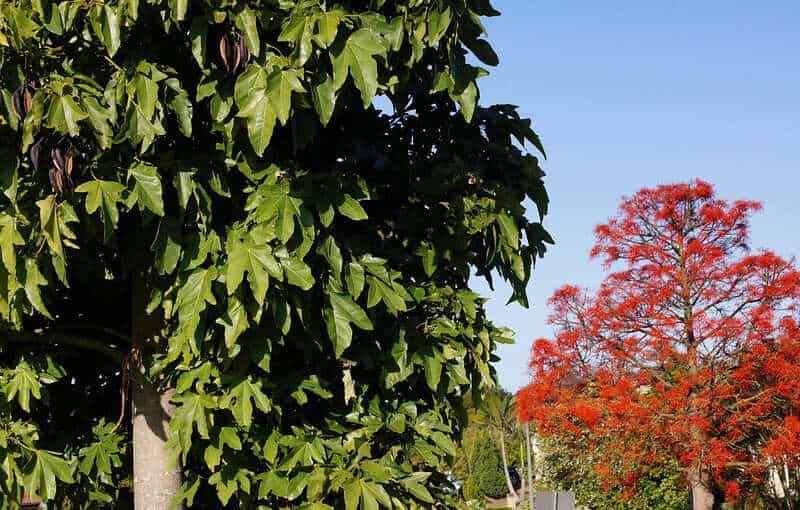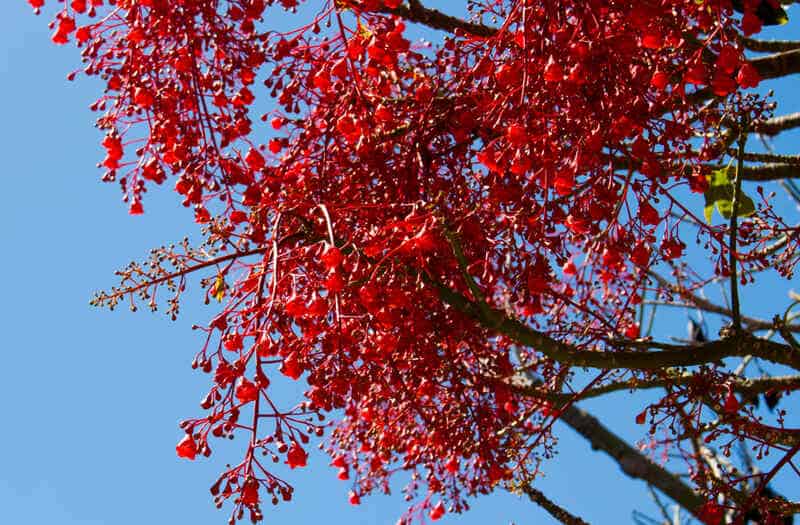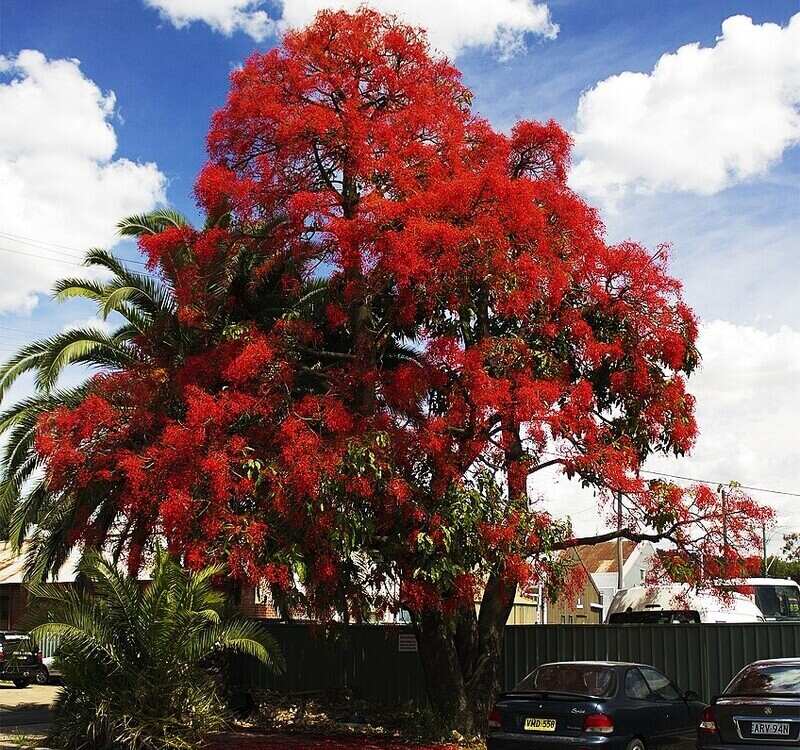They’re a familiar sight around Australia, with their brilliant red blooms following the purple jacarandas in late spring.
All over New South Wales and up the east coast to Queensland, the Illawarra flame tree (brachychiton acerifolius) is bursting into bloom. It is native to Australia, actually, with a long history with indigenous peoples.
If you’ve been curious about this vivid scarlet tree and its bell shaped flowers, here’s a quick rundown about Illawarra flame trees and how to grow one.
About The Illawarra Flame Tree

Brachychiton acerifolius is a deciduous tree, and one of the most spectacular of our Australian native plants. In the wild, it can grow up to 35m, but in gardens, it will reach 10m at most with regular maintenance.
The green leaves are oval-shaped, about 10–30cm long, and turn yellow in autumn for a different kind of colourful display.
But the plants are best known for their bright red, bell shaped flowers, which burst into bloom during late spring and early summer. They bloom in clusters, with each flower measuring about 1–2cm in length.
If grown from seed, it will take around 5–8 years before the tree flowers. If you’re going to plant one, you’ll have to be patient. But Illawarra trees don’t flower annually — they need a dry, mild winter to bloom!
When they finish wilting, the plant will hold dark brown seed pods in their place.
Besides the aesthetic appeal, the flame tree has a long history with indigenous Australians. They have uses for all parts of the tree, such as:
- Cooking the seeds, which are rich in protein
- Using the inner bark for string and fishing nets
- Using the bark and branches for traps

Growing An Illawarra Flame Tree
Illawarra flame tree grows best in full sun, but will tolerate up to partial shade. It will adapt to any soil type so long as it drains well. It’s best suited to temperate and tropical climates, which is why it thrives in New South Wales up to far north Queensland.
It’s important to note that an Illawarra tree’s roots are considered invasive if you plant too close to a structure. The roots could damage the foundational structures, so if you’re planning for a tree in your backyard, keep it 10m away from any structure — especially your house!
It’s best to propagate a flame tree from a seedling or nursery plant. Dig a hole twice as wide as the root ball, and the same depth. Remove the plant from its container, teasing the roots and removing any tangles.
Position the root ball in the hole and backfill. Carefully firm up the earth around it, forming a raised ring around the plant to guide any moisture down. Water well while establishing, but sparingly when mature.
If needed, consult with a professional gardening service regarding soil prep or backyard maintenance to ensure these native trees thrive while flowering.
You can also grow an Illawarra tree from seed! Steep the seeds in a small bowl of hot water for 24 hours. Remove them afterwards, then dry with a paper towel. Plant two to three seeds per pot, with each seed pushed about 2.5–3cm deep. Place in a water tray, or water regularly while the seeds are developing.
When the seedlings sprout, transfer to where they can get at least six hours of sunlight a day. At 5cm tall, transplant so you have one flame tree seedling per pot. You can then transplant them to your garden once they’re established.

Flame Tree Care
Flame trees need regular watering when young and developing, but will tolerate drought when mature. Water a little more during dry months so the trees don’t dehydrate.
You can mulch around the base with organic matter, so long as you keep it away from the trunk. If fertiliser is needed, feed in autumn and spring.
For pruning, this is best done in late summer, after the Illawarra flame tree has finished flowering. Cut back any dead or damaged branches to help keep its shape and keep it healthy. You can also prune leaves two to three times a year to keep them from growing too large.
Flame trees can tolerate light frost, but make sure you check on them in winter!
The Illawarra flowers offer plenty of nesting room for birds, and they can also attract native butterflies. If you’re going to plant one, be ready to welcome some local wildlife!

